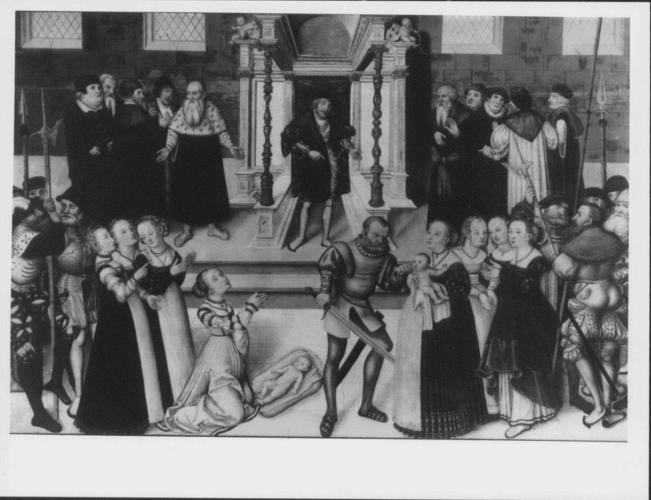The Judgement of Solomon Signed and dated 1519
Oil on panel | 115.3 x 169.2 cm (support, canvas/panel/stretcher external) | RCIN 406032

Attributed to Lucas Cranach the Elder (1472-1553)
The Judgement of Solomon Signed and dated 1519
-
The Judgement of Solomon is a biblical tale from 1 Kings 3:16-28. It tells the story of two women who came to the King with two young babies- one alive and one dead. Both claimed that the living child was their own and that the other woman was only pretending to be the mother of the surviving infant. Solomon, using the wisdom of God, lays a trap for the women. He orders his soldier to cut the living baby in two so that both mothers could have half each. The real mother cried out ‘Please Lord, give her the live child. Do not kill him!” whilst the liar exclaimed “It shall be neither mine nor yours- divide it.” Thus it becomes clear which of the women has true maternal love for and a protective instinct towards the living the child, allowing Solomon to determine which mother the newborn belongs to. This painting depicts the moment of action when the soldier has raised his sword to slay the baby. The boy’s real mother kneels on the floor begging Solomon, who stands in the centre of the scene, to spare the child’s life. On the floor in front of her the already dead infant is laid on a swaddling cloth- a stark reminder of the possible fate of the other child who is sitting dynamically in the false-mother’s arms. Surrounding the main protagonists are councillors, soldiers and women of the court. They all appear animated and in discussion, no-one quite sure of how the King intends to solve the problem, or perhaps horrified that he has demanded the death of the living infant. One councillor in particular, to the left of Solomon stands with his hands outstretched; a gesture denoting bewilderment and uncertainty. He is clearly an old gentleman and his long white beard ought to signify his wisdom. This is strongly contrasted with the young and vigorous King who, despite his age, shows himself to be the wiser man; something he celebrates as a consequence of his relationship with God. The crowd of people depicted in the scene are important because the Bible decrees that after this event Solomon’s reputation grew greatly; there were many witnesses available to see his good-sense and insight. Prince Albert (1819-1861) had a great appreciation of early German art, and was significantly interested in acquiring these works for the Royal Collection. By 1846 Prince Albert already owned a number of Cranach paintings and a further indication of his admiration for the artist is shown through the acquisition of the present work, which was given to the Prince by his wife Queen Victoria as a gift in August 1860.
Provenance
Bought in 1860 for £106 1s by Queen Victoria (accounts for 1860, WRA, PP2/42, 428, 7 Apr 1860); given to the Prince Consort on 26 August, 1860; recorded in the State Visitors' Dressing Room no 238 at Buckingham Palace in 1876
-
Creator(s)
(nationality) -
Medium and techniques
Oil on panel
Measurements
115.3 x 169.2 cm (support, canvas/panel/stretcher external)
136.3 x 190.1 x 9.3 cm (frame, external)







